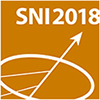Speaker
Description
Heavy metal/ferromagnetic insulator (HM/FMI) heterostructures provide a unique platform for the generation and detection of pure spin currents in the fields of spintronics and spin caloritronics. In these HM/FMI heterostructures, the transport of the spin current across the HM/FMI interface is of key importance. Thereby the quality of the interface highly affects the interfacial interaction between the angular momentum and the HM conduction electrons.
To investigate possible intermixing effects in HM/FMI heterostructures, we study Pt/Y$_3$Fe$_5$O$_{12}$ bilayers with differently arranged layers and different interface properties using x-ray magnetic circular dichroism and x-ray resonant magnetic reflectivity combined with magnetotransport studies. For standard Pt/Y$_3$Fe$_5$O$_{12}$ bilayer samples with sharp and clean interfaces we do not detect any induced magnetic moments in Pt. These samples show an angle-dependent magnetoresistance behavior, which is consistent with the established spin Hall magnetoresistance [1]. In inverted Y$_3$Fe$_5$O$_{12}$ /Pt bilayer samples with gradual and intermixed interfaces, however, Pt displays a finite induced magnetic moment comparable to that of all-metallic Pt/Fe bilayers. In these samples, we find a superposition of the spin Hall magnetoresistance and the anisotropic magnetoresistance. Both effects can be disentangled from each other due to their characteristic temperature dependence.
[1] H. Nakayama et al., Phys. Rev. Lett. 110, 206601 (2013).

